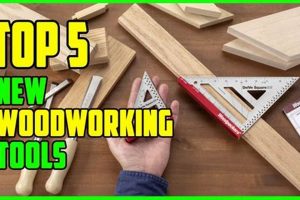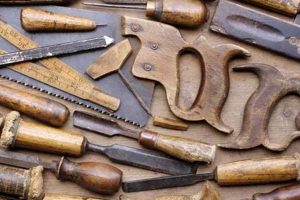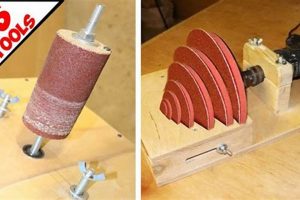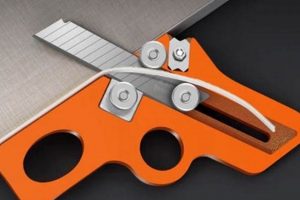Electrically powered implements utilized in the shaping, cutting, and joining of wood, manufactured typically prior to the widespread adoption of modern safety standards and computerized controls, represent a distinct category of equipment. These implements, often characterized by robust construction and mechanical simplicity, were integral to professional and amateur woodworking practices for much of the 20th century. Examples include belt sanders, table saws, and drill presses from manufacturers such as Delta, Craftsman, and Powermatic produced before the 1980s.
The enduring appeal of these older machines stems from several factors. Their heavy-duty construction often translates to superior vibration dampening and long-term durability compared to some modern counterparts. Many craftspeople appreciate their mechanical simplicity, which facilitates easier repair and maintenance. Furthermore, the historical context and aesthetic design of these tools provide a tangible link to past eras of craftsmanship, appealing to collectors and enthusiasts. Their acquisition and restoration represent a form of historical preservation and a commitment to sustainable practices through reuse.
Understanding the characteristics, restoration techniques, and safe operational practices associated with these pre-contemporary electrically powered woodworking aids is essential for anyone seeking to integrate them into a modern workshop. Subsequent sections will delve into specific types of equipment, common restoration challenges, and crucial safety considerations.
Tips for Working with Vintage Woodworking Power Tools
The effective and safe utilization of older electrically powered woodworking implements necessitates a dedicated approach to maintenance, operation, and understanding of inherent limitations.
Tip 1: Thorough Inspection is Crucial: Prior to operation, conduct a comprehensive inspection of the tool. Check for frayed cords, damaged switches, loose components, and signs of rust or corrosion. Replace or repair any defective parts before initiating use. For example, a cracked belt guard on a bandsaw presents an immediate safety hazard.
Tip 2: Prioritize Safety: These tools often lack modern safety features. Wear appropriate personal protective equipment, including safety glasses, hearing protection, and dust masks. Ensure that blade guards and other safety mechanisms are properly installed and functional. A table saw without a functioning riving knife significantly increases the risk of kickback.
Tip 3: Master Fundamental Techniques: Understand the correct operating procedures for each specific tool. Consult original manuals or reputable resources for guidance. Practice on scrap material to develop proficiency and avoid damaging valuable stock. Attempting intricate cuts on a jointer without proper training can lead to material waste or injury.
Tip 4: Regular Maintenance is Essential: Implement a regular maintenance schedule. Clean the tool after each use, lubricate moving parts, and sharpen blades or bits as needed. Neglecting maintenance can lead to decreased performance, increased wear, and potential malfunctions. A dull blade on a circular saw requires more force and increases the risk of binding.
Tip 5: Understand Material Limitations: Older machines may not be suitable for processing certain materials, such as thick hardwoods or composites. Consult the tool’s specifications and adjust feed rates accordingly. Overloading the motor can cause overheating or damage. Forcing a workpiece through a planer beyond its capacity risks damaging the machine or the material.
Tip 6: Grounding is Paramount: Ensure the tool is properly grounded. Use a three-prong plug and a grounded outlet. If the tool has a two-prong plug, consider replacing it with a three-prong plug and connecting the ground wire to the tool’s chassis. Improper grounding poses a significant risk of electric shock.
Tip 7: Research and Restoration: Consider restoring the tool to its original condition. Research the tool’s history, specifications, and original parts. Replace worn or damaged components with original or compatible replacements. A properly restored tool will perform better and last longer.
Adherence to these guidelines promotes safer and more effective utilization, extending the lifespan of the tool and enhancing the quality of woodworking projects.
The following sections will explore specific examples and case studies of older powered woodworking implements in practice.
1. Durability and Longevity
The extended operational lifespan of many older electrically powered woodworking implements stems from design and manufacturing philosophies prioritizing robust construction and component over-engineering. Machines produced during the mid-20th century frequently employed heavier castings, higher-grade steel, and simpler mechanical designs compared to some contemporary counterparts. This emphasis on durability resulted in tools capable of withstanding decades of consistent use, even under demanding conditions. A direct consequence of this build quality is the continued availability of these machines in functional condition, often requiring only routine maintenance or component replacement to remain operational. For instance, a well-maintained Powermatic Model 66 table saw manufactured in the 1960s can often outperform newer, lighter-duty models in terms of vibration dampening and cutting precision.
The practical significance of understanding the relationship between durability and longevity in older woodworking equipment lies in informed acquisition and maintenance strategies. Potential buyers can assess the condition of a tool based on its construction characteristics, identifying potential areas of weakness or wear. Moreover, proper maintenance practices, such as regular lubrication and timely component replacement, can further extend the operational life of these machines. This approach minimizes the need for frequent tool replacements, reducing long-term costs and promoting sustainable practices. Consider the example of vintage jointer; regular blade sharpening and meticulous alignment of the infeed and outfeed tables contribute significantly to its continued accuracy and efficiency.
In summary, the durability and longevity of vintage woodworking power tools are not merely historical curiosities but critical attributes that contribute to their enduring value. The robust construction and simpler designs of these machines offer a compelling alternative to some modern tools, particularly for users who prioritize long-term performance and sustainability. The ability to assess, maintain, and restore these tools represents a valuable skill set for woodworkers seeking to leverage the benefits of equipment designed to endure. The challenge remains in balancing the advantages of durability with the inherent safety limitations of older designs.
2. Mechanical Simplicity
The defining characteristic of many electrically powered woodworking implements produced prior to the late 20th century is their relative mechanical simplicity. This design philosophy, often dictated by the technological limitations of the time, resulted in machines with fewer moving parts, readily accessible components, and straightforward operational mechanisms. The effect of this simplicity is twofold: reduced complexity in maintenance and repair, and increased inherent reliability. For example, a vintage belt sander typically employs a direct-drive motor connected to rollers via belts and pulleys, a system far less intricate than some contemporary variable-speed electronic controls. The importance of this design attribute lies in its contribution to the longevity and maintainability of these tools.
One practical consequence of mechanical simplicity is the ease with which these tools can be diagnosed and repaired. The absence of proprietary electronic components and complex programming allows skilled technicians, and even knowledgeable users, to troubleshoot and resolve issues using readily available parts and standard tools. Consider a situation involving a vintage drill press; a faulty capacitor in the motor circuit can be identified and replaced without requiring specialized diagnostic equipment or software. Furthermore, the straightforward nature of the mechanical systems facilitates upgrades and modifications, allowing users to adapt the tool to specific needs. An example of this is replacing the standard fence on a vintage jointer with a more precise and adjustable aftermarket model.
In conclusion, the mechanical simplicity of vintage woodworking power tools is a critical factor contributing to their enduring appeal. This design characteristic fosters ease of maintenance, enhances reliability, and allows for straightforward modification and repair. While modern tools often offer advanced features and electronic controls, the simplicity of their predecessors offers a compelling alternative for users who value ease of use, maintainability, and a reduced reliance on proprietary components. The main challenge remains in sourcing replacement parts for less common models, but the inherent simplicity of the design often allows for creative solutions and the adaptation of readily available components.
3. Restoration Requirements
The restoration of older electrically powered woodworking implements constitutes a complex undertaking, necessitating a thorough understanding of mechanical principles, materials science, and historical context. The following points outline the critical facets of this process, highlighting the skills and resources required to return these machines to safe and functional condition.
- Disassembly and Cleaning
The initial stage involves complete disassembly of the tool to facilitate thorough cleaning. This process removes accumulated grease, rust, and debris that can impede proper operation. The use of appropriate solvents and abrasive techniques is essential to avoid damaging original finishes or components. For example, the removal of hardened grease from the bearings of a vintage bandsaw requires careful application of degreasers and manual cleaning to prevent damage to the bearing surfaces.
- Component Inspection and Repair/Replacement
Each component must be carefully inspected for wear, damage, or corrosion. Worn bearings, frayed wiring, and cracked castings are common issues. Repair may involve machining new parts, welding broken components, or sourcing original or compatible replacements. The availability of original replacement parts can be limited, often necessitating fabrication or adaptation of existing components. A common example is replacing the motor bearings on a vintage drill press, which may require identifying and sourcing specific bearing sizes that are no longer readily available.
- Electrical System Refurbishment
The electrical system of an older tool often requires extensive refurbishment. This includes replacing frayed or damaged wiring, upgrading the grounding system, and installing new switches and controls. The installation of a modern overload protection system is crucial for safety. An example is replacing the original two-wire system of a vintage table saw with a three-wire grounded system to mitigate the risk of electric shock.
- Calibration and Adjustment
Following reassembly, precise calibration and adjustment are essential to ensure accurate and safe operation. This includes aligning tables, adjusting blade guides, and verifying speeds. Specialized tools and knowledge are often required to achieve optimal performance. An example is calibrating the fence and blade alignment on a vintage jointer to ensure precise edge jointing and avoid material kickback.
These restoration requirements underscore the commitment necessary to preserve and utilize older electrically powered woodworking implements. Successfully navigating these challenges yields functional tools imbued with historical significance, offering a compelling alternative to modern equipment for skilled craftspeople. The process exemplifies sustainable practices through the reuse and revitalization of durable machinery, linking woodworking traditions with contemporary environmental consciousness.
4. Safety Considerations
The utilization of older electrically powered woodworking implements necessitates a heightened awareness of safety protocols and potential hazards. Equipment manufactured prior to the widespread adoption of modern safety standards presents unique challenges that demand careful consideration and proactive risk mitigation. Operators must recognize the inherent limitations of these machines and implement appropriate safeguards to ensure safe working practices.
- Absence of Modern Safety Features
Many older tools lack features commonly found on contemporary models, such as blade guards, anti-kickback devices, and emergency shut-off systems. The absence of these features requires the operator to exercise increased vigilance and implement alternative safety measures. For instance, a vintage table saw without a riving knife significantly increases the risk of workpiece kickback, necessitating the use of featherboards and push sticks.
- Electrical System Integrity
The electrical systems of older tools are often outdated and may not meet current safety standards. Frayed wiring, deteriorated insulation, and inadequate grounding pose significant electrical shock hazards. A thorough inspection and refurbishment of the electrical system, including the installation of a modern grounding system and overload protection, is essential. Replacing the original two-wire cord on a vintage drill press with a three-wire grounded cord provides a vital safety upgrade.
- Mechanical Component Condition
Worn or damaged mechanical components can compromise the safety of older tools. Loose belts, worn bearings, and cracked castings can lead to unexpected malfunctions and potential injury. Regular inspection and maintenance of these components are crucial. For example, a cracked bandsaw blade guide can cause the blade to wander, increasing the risk of inaccurate cuts and potential blade breakage.
- Operator Training and Experience
The safe operation of older woodworking tools requires specialized knowledge and experience. Operators must be thoroughly familiar with the tool’s operating characteristics, potential hazards, and appropriate safety procedures. Formal training and supervised practice are highly recommended. Attempting to use a vintage jointer without proper instruction can lead to material kickback and potential injury.
In summary, the safe integration of these older electrically powered woodworking implements into a modern workshop environment demands a comprehensive understanding of their limitations and the implementation of proactive safety measures. The absence of modern safety features, potential electrical hazards, compromised mechanical components, and the need for specialized operator training all contribute to the heightened risk profile of these tools. A commitment to thorough inspection, diligent maintenance, and rigorous adherence to safety protocols is essential for mitigating these risks and ensuring a safe working environment. The focus remains on balancing the historical significance and potential utility of these machines with the paramount importance of operator safety.
5. Historical Significance
The historical significance of electrically powered woodworking implements manufactured before the widespread adoption of modern computerized controls and safety standards resides in their tangible connection to the evolution of industrial and craft practices. These tools represent a specific era of technological development, reflecting the available materials, engineering philosophies, and manufacturing capabilities of their time. Their existence and continued use offer insights into the transition from hand tools to powered machinery, illustrating the increasing mechanization of woodworking processes during the 20th century. For example, the gradual shift from cast iron frames to lighter, stamped steel components in power tools reflects both advancements in materials science and a changing emphasis on cost-effectiveness in manufacturing. The presence of specific design features, such as open motors and unguarded blades, serves as a stark reminder of the safety standards prevalent in earlier periods.
The preservation and study of these older implements provide a valuable resource for understanding the social and economic contexts in which they were produced and utilized. These devices were instrumental in shaping industries, influencing furniture design, and enabling mass production techniques. Examining the branding and marketing of these tools reveals insights into consumer culture and the aspirations of both professional woodworkers and hobbyists. A Craftsman table saw from the 1950s, for example, reflects the post-war boom in homeownership and the growing popularity of do-it-yourself projects. Furthermore, the study of patents and manufacturing records associated with these tools contributes to a broader understanding of technological innovation and the competitive dynamics within the power tool industry.
Appreciating the historical significance of implements not only enriches the experience of working with them but also fosters a deeper understanding of the craft itself. Recognizing the design principles and manufacturing techniques employed in these tools allows users to make informed decisions regarding their operation, maintenance, and restoration. Furthermore, the preservation of these devices serves as a tangible link to the past, connecting contemporary woodworkers with the traditions and innovations of previous generations. The challenge lies in balancing the preservation of historical artifacts with the practical need for safe and efficient woodworking practices.
6. Operational Techniques
The effective utilization of older electrically powered woodworking tools is inextricably linked to the application of appropriate operational techniques. These techniques, often differing significantly from those employed with modern equipment, are crucial for ensuring accuracy, safety, and the longevity of implements. The absence of computerized controls and advanced safety features in older machines necessitates a deeper understanding of the tool’s mechanical workings and inherent limitations. Improper techniques can lead to inaccurate cuts, material damage, machine malfunction, or, most critically, operator injury. For example, forcing a workpiece through a vintage jointer without proper infeed and outfeed support can result in severe kickback, posing a significant safety risk.
The mastery of operational techniques for these tools involves both theoretical knowledge and practical experience. Understanding the relationship between blade speed, feed rate, and material hardness is essential for achieving optimal cutting performance. Developing a refined sense of “feel” for the machine’s operation allows the operator to anticipate potential problems and make adjustments accordingly. Regular practice on scrap material is critical for honing these skills. The process of accurately resawing a thick board on a vintage bandsaw, for instance, requires a combination of blade selection, feed pressure control, and the use of appropriate guides to compensate for blade drift. Successful implementation of these techniques preserves the tool’s functionality and enhances the quality of the woodworking projects.
In summary, the successful and safe operation of vintage woodworking power tools hinges upon a deep understanding and application of appropriate operational techniques. These techniques, often requiring specialized knowledge and practical experience, mitigate the risks associated with the absence of modern safety features and computerized controls. The ability to master these techniques not only enhances the functionality of the tool but also promotes safe working practices and contributes to the preservation of valuable woodworking traditions. The challenge is to balance historical appreciation with a commitment to modern safety standards and the effective adaptation of older machines to contemporary woodworking practices.
7. Material Limitations
Material limitations are a critical consideration when utilizing older electrically powered woodworking implements. These tools, designed and manufactured for the materials and applications of their era, often exhibit performance constraints when processing contemporary materials or undertaking tasks beyond their original intended scope. Recognizing these limitations is crucial for ensuring safe operation, preventing equipment damage, and achieving desired results.
- Hardwood Processing Capacity
Older machines may possess insufficient horsepower or structural rigidity to effectively process dense hardwoods such as maple, oak, or walnut, particularly in large dimensions. Attempting to mill hardwoods beyond the tool’s capacity can result in motor overheating, reduced cutting precision, and increased risk of kickback or material binding. For example, a vintage bandsaw with a low-horsepower motor may struggle to resaw thick oak boards, leading to blade wander and a rough, uneven cut.
- Engineered Wood Products
Tools designed prior to the widespread adoption of engineered wood products, such as plywood, MDF, and particleboard, may not be optimized for processing these materials. The abrasive nature of these composites can accelerate blade wear and generate excessive dust, potentially damaging the tool’s internal components. Furthermore, the glue content in engineered woods can cause blade gumming and reduce cutting efficiency. A vintage table saw, for instance, may exhibit excessive tear-out when cutting plywood due to the blade’s tooth geometry and cutting speed.
- Material Thickness and Dimensions
Older machines often possess limited capacity in terms of material thickness and dimensions. A vintage planer may have a restricted maximum cutting height, precluding the processing of thick stock. Similarly, a vintage lathe may have a limited swing diameter, restricting the size of workpieces that can be turned. Attempting to exceed these limitations can result in material damage or equipment malfunction.
- Abrasive Materials
Certain materials, such as abrasive plastics or composites containing fillers, can rapidly wear down the cutting edges of blades and bits used in older implements. This accelerated wear can compromise cutting accuracy and increase the risk of tool failure. Processing these materials may also require specialized blades or bits designed for abrasive applications. A vintage router, for instance, may experience rapid bit dulling when used to cut phenolic composites.
In summary, the inherent limitations of vintage woodworking power tools necessitate careful consideration of the materials being processed. Understanding the tool’s design characteristics, motor power, and material compatibility is crucial for achieving safe, efficient, and accurate results. Exceeding these limitations can lead to equipment damage, material waste, and potential operator injury. The careful selection of appropriate materials and the implementation of proper cutting techniques are essential for maximizing the performance and longevity of these older machines.
Frequently Asked Questions
The following section addresses common inquiries and concerns regarding the acquisition, restoration, and operation of electrically powered woodworking implements manufactured prior to the widespread adoption of modern safety standards and computerized controls. The answers provided aim to offer clarity and guidance for those considering integrating these tools into a contemporary woodworking practice.
Question 1: What are the primary benefits of using tools?
These machines are often characterized by robust construction, mechanical simplicity, and long-term durability, potentially offering superior vibration dampening and ease of maintenance compared to some modern counterparts. The historical context and aesthetic design of these tools can also provide a unique appeal for collectors and enthusiasts.
Question 2: What are the main risks associated with their operation?
These machines often lack modern safety features, such as blade guards, anti-kickback devices, and emergency shut-off systems. Outdated electrical systems, worn mechanical components, and the need for specialized operator training also contribute to an elevated risk profile.
Question 3: What specific restoration steps are typically involved?
Restoration typically encompasses complete disassembly and cleaning, thorough component inspection and repair/replacement, electrical system refurbishment, and precise calibration and adjustment. Sourcing original or compatible replacement parts can present a significant challenge.
Question 4: Are there limitations regarding materials that these can process?
These tools may exhibit performance constraints when processing dense hardwoods, engineered wood products, or abrasive materials. Material thickness and dimensional limitations can also restrict the tool’s applicability for certain projects.
Question 5: How does maintenance for these differ from modern tools?
While the fundamental principles of maintenance remain consistent, the mechanical simplicity of older tools often allows for easier diagnosis and repair. However, sourcing replacement parts may require specialized knowledge and fabrication skills. Regular lubrication, blade sharpening, and belt tension adjustments are critical for maintaining optimal performance.
Question 6: Is it possible to enhance the safety of vintage tools?
Yes, several modifications can improve safety. These include upgrading the electrical system with grounding and overload protection, installing aftermarket safety devices, and implementing strict adherence to personal protective equipment requirements. Formal training and supervised practice are also essential for safe operation.
The preceding answers underscore the importance of careful evaluation, informed decision-making, and a commitment to safety when working with pre-contemporary, electrically powered woodworking aids. A nuanced understanding of their capabilities and limitations is crucial for achieving both efficient and safe operation.
Subsequent discussions will explore specific case studies and practical examples of the tools in operation, further illustrating their capabilities and the challenges associated with their use.
Conclusion
The preceding exploration of electrically powered woodworking implements manufactured prior to modern computerized controls underscores the enduring appeal and inherent challenges associated with these tools. Robust construction, mechanical simplicity, and historical significance are juxtaposed against the absence of contemporary safety features and the potential for material limitations. Effective utilization requires a commitment to diligent restoration, rigorous adherence to safety protocols, and a nuanced understanding of appropriate operational techniques.
The decision to integrate vintage woodworking power tools into a modern workshop environment demands careful consideration of both their potential benefits and inherent risks. Responsible stewardship necessitates a dedication to preservation, restoration, and safe operating practices, ensuring that these tangible links to the history of woodworking continue to inform and inspire future generations of craftspeople. Continued research and documentation of these tools are essential for preserving knowledge and promoting responsible use.







